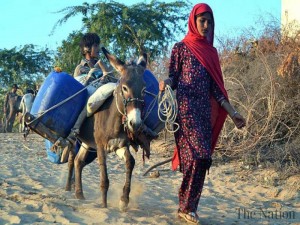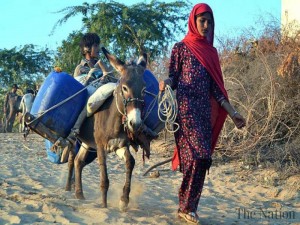- Children are dying at an alarming rate here but underneath the numbers lie tales of a region neglected and in ruins.
Al Jazeera
Faras Ghani
Part II
 There is insufficient food for the family. The mother looks after the children, the livestock and goes to collect water and firewood several times a day.
There is insufficient food for the family. The mother looks after the children, the livestock and goes to collect water and firewood several times a day.
A recent UN-funded survey found 90 percent of Thari women to be underweight, with a mean weight of 44.2kg.
Almost 93 percent of households do not have any food-buying powers, surviving mostly on seasonal harvests that are monsoon-dependent and the sale of livestock.
Pratab, an educationist and social activist in Tharparkar, describes the life of a Thari woman: “A male does no work at home. He only works on the field during seasons. He will wake up in the morning and ask for tea. If there is no milk, the women will go next door to get milk. There is no milk for the kids to drink but for tea, it is a must. And cigarettes.
“The female will eat whatever is left, if anything. She will wake up before everyone else, fetch water, cook, send the kids to school, among other chores. You look at their daily lives and you will be surprised how they are living. According to the males, a female does not do any ‘work’ because they consider ‘work’ as something that brings in money. It is a very sad and oppressed life for the women of Tharparkar.”
‘The longer we keep an adolescent girl unmarried, the bigger our sins will be’
Early marriage, teen pregnancies and an absence of family planning has become a norm in the district.
It is 9am on a hot, windy summer’s day in Mithrio Soomro village when local women gather around a well to collect water. Aqeela, who says she has “10 to 12” children, is pulling the thick, rough rope tied to the well along with a few other women – a job typically assigned to a donkey.
As the conversation turns towards the number of children each woman has, some shy away from the question while others respond with “eight”, “six”, “10” or “12”.
Aqeela says with pride that she married her daughter off as soon as she turned 12. “My girl was sitting in school aged 13 with a baby in her belly,” she says with a chuckle.
The local mosque’s imam, they say, implores them to marry their daughters off as soon as they hit puberty. “He [the imam] says the longer we keep a baaligh [adolescent] girl unmarried, the bigger our sins will be.”
The Pakistan Electronic Media Regulatory Authority (PEMRA) recently directed all TV and FM radio channels to stop airing family planning ads as the “general public is very much concerned on the exposure of such products to the innocent children, who get inquisitive on features and use of the products”.
The ban was later tweaked to allow such ads after 11pm.
Although the ban means little in Tharparkar, where few have electricity, Dr Najma Khoso, a gynaecologist at Nagarparkar Hospital, is irked by it.
“What corruption can a family planning ad cause?” she asks. “This is awareness.”
“Sex education should also be preached on TV so that people know that this is a reality. We are still looking for God’s name in potatoes, but when someone with forward thinking comes out, we deem it un-Islamic.”
Khoso is the only female doctor in the area. In the two years she has been at the hospital, she says she has witnessed a gradual change in the thinking of the locals.
“There is lack of awareness as to when they should consult doctors or come to health facilities. If they do decide to come, transportation and limited finances make them think again.
“Malnutrition is a major factor in the deteriorating health of Thari females. There are even some who are able to afford the right food but aren’t aware of what they need to eat. Others get nothing but bread and milk,” she says.
There has been a gradual rise in awareness of family planning in registered villages. But almost half of the villages in the district are unregistered and hence, not on the map. But young women from those villages are now being taught about family planning.
In January, 759 females were trained and sent back to their communities.
Khadija, 35, is a midwife from the village of Mithrio Soomro. Her life is typical of many Thari women. But she is striving to make a difference.
“I wake up, send [the] kids to school, milk the goats and send the milk away to sell,” explains the mother of two.
“I get help from my parents and uncles. Then I come to the dispensary at 9am and leave at 2pm. I do housework and take [the] livestock for grazing …. While my salary on appointment was 14,000 rupees [$134], I haven’t been paid for a year,” she says.
All of the women from the village come to Khadija. While there are no doctors at the dispensary, Khadija can complete basic check-ups and hand over medicine with the help of the dispenser.
Khoso says change is happening – but slowly.
“There are some men in favour of family planning. But then I’ve seen cases where a woman comes in with one kid in her lap, one holding her hand and one unborn child in her belly. We ask them how they feed the infant, do household chores or look after themselves during pregnancy.
“They promise us they’ll stop having children but are not able to do it. We do see some effect of our efforts, but it’s a very slow change.”
‘It seems as if half our life is spent fetching water’
“The wells in our villages have dried up. People, mostly women and children, travel six to seven kilometres multiple times a day to fetch water. It seems as if half our life is spent fetching water,” says Sandhu.
She is at a water filtration plant where she hopes to stock up.
The majority of Tharparkar’s residents have no access to clean drinking water. There are no water pipelines going deep into the villages. Wells have been dug up by the government, NGOs, social workers and by villagers themselves, but a lack of rainfall and inadequate maintenance mean they have either dried up or their contents are unsafe for human consumption. Still, most residents have no choice but to consume it.
Reverse osmosis water plants, which run on solar power, have been set up in the region. Residents flock to them multiple times a day, braving the heat, exhaustion and long journeys.
“I’ve been trained as a midwife, and I can say that water issues in the villages cause a lot of diseases and complications at childbirth, too,” Sandhu says.
“We used to have a major water crisis in the villages. And not just for us humans, but our livestock as well. We used to collect rainwater, but the scarcity of rain left us with dry lands.”
A UN-funded survey by HANDS established that around 30 percent of women and children in the region travelled over an hour to a water supply.
Muhammad Irshad is an installation manager at PakOasis, the company which created the water plant and more than 700 smaller ones, in conjunction with the provincial government.
Irshad leads a tour of Asia’s largest desalination complex, which is located in Tharparkar.
“There is too much salt, iron, sulphate and fluoride in the groundwater here,” he explains. “We dig up a well 800 to 1,100 feet deep in close vicinity to this plant and pump water here to be treated. Only Mithi gets water through pipelines. The rest of the district either uses our smaller plants, which are sparsely located, or they still rely on the traditional wells in their villages.”
Irshad fills a glass with untreated water from the wells and asks us to drink it. It is unbearably salty and contains other harmful minerals that we cannot taste.
“This,” he says pointing at the water, “is what the majority of Tharparkar residents had to drink.”
At a smaller plant a few kilometres from the main road, women line up plastic water containers and earthen pots. Children are entrusted with making sure the donkeys get their share before the long journey home in the heat.
For most, it is not their first trip of the day – or their last.
‘Change will only come when you educate yourself’
Almost half of Tharparkar’s 1.5 million population are children.
Of that, 165,000 are enrolled in the district’s poorly-run education system, according to provincial government statistics from 2013-14, with only 30,000 of those staying in school beyond primary education.
Just under 1,800 are enrolled in college and only 350, out of the whole population, go on to attend university.
“Ultimately, the entire population of Tharparkar is dependent upon 350 shoulders,” Pratab tells Al Jazeera.
The district’s literacy rate is below 20 percent. There are approximately 4,000 schools in the region and 90 percent of these are primary. The majority consist of a single room.
“Every other school is closed. In villages, almost 80 percent of schools are closed. The literacy rate among girls is an appalling 6.9 percent. That’s because even fewer girls are sent to school,” Pratab says.
“You’ll see a stark contrast when you reach urban areas. Schools are open, teachers are present and education is great.”
According to a government survey, 973 schools are shut, and only 190 out of 4,045 schools have electricity, while 1,634 have boundary walls. Almost 2,500 have no toilet facilities. More than 5,000 teachers are registered, but many are not working where they are supposed to be.
“I know of this female teacher who used to live 25km from the school. It would cost her 30,000 rupees [$287] per month to go back and forth. Her salary is a meagre 16,000 rupees [$153],” Pratab explains.
When Al Jazeera visited the region, schools were closed for the summer.
But in one remote village, the children gathered for our visit and began counting in Sindhi. The board had the attendance marked on it in English, but none of the children were able to read it.
“There are 18 children registered in this school, which runs for six hours daily,” a local explained.
“The kids are aged five to 12, and they all study in the same room. They only get taught in Sindhi. There are no English teachers or syllabus here.”
There is only one English medium primary school in the district, according to the government’s 2013-14 census, with three Urdu schools. The rest teach in Sindhi.
The shortfall in education is considered one of the main obstacles holding the region back.
“The care provider at home is mainly the mother, and if she is not educated, there is no one to teach the kids anything,” Mohan Lal Khatri, the childcare specialist at Civil Hospital Mithi, explains.
The government says it is willing to pay high salaries to the teachers and is already doing so. “We are making efforts to improve things,” explains Nisar Ahmed Memon, Tharparkar’s deputy commissioner. “And we realise there’s a lot of work to be done. We are trying to fix the issues and make as many schools functional as possible. But we need community involvement as well. People do raise their voices, but only when we go and visit them.
“Education will also help solve other matters in society, especially early marriages and frequent pregnancies. More awareness is needed and people need to be educated. So, hopefully, the generation now in school will grow up to be fully aware of these issues and consequences.” But with no incentive to keep them in school, more and more parents are pulling their children out to help with household chores. In Mithrio Soomro, a large village accessible via a paved road, even when girls are sent to school, they are often pulled out and married off as young as 11.
For things to improve, that mindset needs to change, Pratab says.
“Change will only come when you educate yourself,” he adds.
Living off livestock
Every Sunday, Mithi plays host to a goat and sheep market.
Buyers come from as far away as Lahore, having driven for two days to cover the 1,300km distance. Trucks are loaded with goats of all sizes and colours before setting back out on the long journey.
One of the drivers explains that most of the meat will be exported around the world, fetching them thousands of rupees. Some will be kept for local consumption.
Most of those here are selling their own flocks and herds, but a few have come to sell the last of the little livestock they have.
The main source of livelihood for Tharparkar’s population is its livestock of 4.6 million animals – donkeys, camels, goats, cow, sheep and mules.
Some of it provides milk for consumption at home and also to sell on a daily basis. Mules are used to carry water from wells and water plants. It is also a last-resort source of quick funds. Unemployment and poverty lead to forced sales, the money often lasting the family just days. For a region and group of people so heavily reliant on livestock, there are only 12 vets in the entire district, according to Pratab.
Low rainfall over the last few years has not only produced a low yield of crops but also affected livestock in Tharparkar, too. In 2014, 88 percent of households in Tharparkar had no income due to those dry seasons, increasing their reliance on livestock.
But the dry season and diseases accounted for the deaths of over 300,000 livestock that year. Of those that survived, many ended up being non-lactating, weak and in poor health due to water scarcity and high temperatures.
In response, the government ran livestock vaccination programmes across 68 villages. But locals complain that it was not enough.
“I just hope adequate rain is on its way this year; that’s the best solution to our problems,” says one local at the goat market.
Tharpakar received its first batch of monsoon rains in June followed by another set this week. It may temporarily help wash away some of the Tharis’ suffering, until the clouds start receding once again …




